| Before 1600 |
| It
seems likely that an early Appleby of my family line came, around or previous
to 1600, from the town of that name in Cumbria (previously Westmorland),
though there is an Appleby in Humberside and an Appleby Magna and an Appleby
Parva near Birmingham. |
Appleby
in Cumbria is first recorded in 1130 as Aplebi. probably Apple Village.
With surnames common in England by 1500 the first Appleby so named would
be likely to have left the village in the 15th century. |
| |
In "The Homes of Family Names"
by Guppy (1890) numbers are given to represent a proportion per 10,000.
For Appleby that proportion is 11 for Derbyshire, 8 for Durham, 9
for Essex, 10 for Yorkshire and 30 for Northumberland.
|
| Thomas
Appleby born c 1615? |
|
Known
from the birth record of his son John in 1636 and also his son William.
A Mary
Appleby married one William Brown in 1647. Could Mary be a sibling of
Thomas, or a daughter? Ian Appleby <ian@iappleby.fsnet.co.uk>
believes Mary is sister to Thomas. |
|
| Johannes
Appleby 1636 - 1696
|
Tracing
the family back some 200 years it is possible to link in with information
in Hodgson's County History of Northumberland (see Volume 5, page 375)
to produce a reasonably certain line back to Johannes Appleby
of Acklington, Northumberland who died 8.5.1696.
|
Acklington
birth records have "John, son of Thomas of Acklington 1636 22
June"
|
Hodgson
also gathered information on this family which shows that there is no
mention of Applebys in the area of Acklington on the muster roll of
1538, nor when surveys were made in 1567, 1585 and 1616. However a 1664
Hearth Tax Survey mentions Wm Appleby with one hearth. Ten people
were named, while 29 were too poor to count.
It
is not impossible that this William was father to Johannes Appleby,
though this remains supposition. Nevertheless evidence suggests that
the Applebys came to Acklington in about 1616, or at least came to financial
prominence at that time. |
In
1762 the Militia List for the 31st March includes:
William Applebe, servant, Warkworth
John Applebe, journeyman, Warkworth
Thomas Appleby, weaver, Morrick
Thomas Appleby, farmer, Acklington
Robert Apeleby, husbandman, Acklington |
Ignoring
the possibility of William (fl. 1664), we start with Johannes
(names were often written in a Latin form in parish registers of this
time) who died in Acklington 8.5.1696.
He
may have married Grace, who died 1.3.1685 and seems a likely candidate
although there is no record of a wedding. |
An "end
of 18th Century" survey shows 18 farms, two of which were owned
by Thomas Appleby and one by John Appleby. Clearly the
Applebys were spreading - but care must be taken not to jump to conclusions
when relating different pieces of information. At times it is impossible
to know which of the many Roberts, Johns, Williams and Thomases are
which. |
| Thomas
Appleby died 1717
|
He
did have a son, Thomas, (date of birth unknown) who himself had
eight children - ->
This
Thomas, on 1st December 1696, took a new lease of the lands formerly
held by his father [Enrolment of Leases, Duke of Northumberland's
MSS]
A ready candidate for his wife is Maria, who died 17.10.1720, although
once more there is no positive proof. |
Isabell (1689),
Johannes (1694),
Margareta (1697),
Thomas (1699),
Robertus (1702),
Josephus (1705),
Gulielmus (1707)
Edvardus (1711). |
| 18th
Century |
| Johannes
(John) Appleby 1694-1768 |
Thomas's
eldest son, Johannes, born 21.10.1694, married Margaret Buston
in Shilbottle on 25.6.1719, having taken a lease of lands owned by his
father and grandfather before him, on 20.1.1718 or 1719. He renewed that
lease on 10.10.1738.
We do have documentary evidence of that land which confirms his family
line: |
Alnwick Castle muniments, survey
of 1727, Acklington, North Side:
John Apleby, late Thomas Apleby ... before him John Apleby ... messuage
and tenement with a garth and ... arable land ... and pasture. Rent £4.
Improved £23. 81/2 frames on north syde ... 860 acres. 0.25. |
Johannes
and Margaret had eight children too - ->
(note that the Maria who we may suppose to have been Johannes' mother
died in the previous year.)
Margaret
died 17.9.1766 and Johannes 17.12.1768, in Acklington. |
Isabella,
Maria (1721)
Isabella (1724),
Margareta (1726),
Anna (1728),
Johannes (1731),
Thomas (1734),
Robertus (1736). |
| Thomas
Appleby 1734-1763 |
Johannes (1694) was one of eight children, (one of whom was Edvardius,
christened 7.9.1711.) |
|
Now
he too married, one Isabel Miller of Brinkburn, and they also had a
child named Thomas. This is where confusion arises. There is
such a profusion of Thomas Applebys at this time that it is unclear
which is which. One of them clearly sired Joseph Appleby who
was born in Warkworth on 11.4.1762, and this Joseph is clearly an ancestor
of the present writer. |
|
However,
which Thomas was his father is not so certain.
• Probably it was Thomas the weaver (of Morwick) mentioned
in the Militia List (born either 8.2.1741 or more
likely 27.12.1747, died 2.12.1763) and probably he was the son of Edward
(1711).
• Possibly it was Thomas the farmer and
• Possibly it was the son of Johannes (1694).
It is almost certain that, whichever Thomas it was, they each had a common
grandfather in Thomas of Acklington (died 1717) and were therefore
cousins. |
Intriguingly, I have a copy of Pilgrim's Progress that belonged to Thomas Appleby of Morwick Hall and is dated 1790. Photographs 1 - 2 - 3 - here.
But who precisely was this Thomas? I'm guessing he was brother to Joseph (b1762) as the father, Thomas, (b 1734) died at Morwick. It's perfectly possible (though unproven) that Thomas was born between 1754 and 1761 and as eldest son inherited Morwick Hall - and kept a copy of Pilfim's Progress in his library. |
| Joseph
Appleby 1762-1837 |
So, one of theThomas Applebys married Jane Huntley in Warkworth
31.5.1761 and one of them had the child, Joseph, christened in
11.4.1762. Thomas died in Morwick 2.12.1763. |
|
Joseph,
almost certainly a very poor man, married Jane Carr (1770) in Ulgham
on 4.6.1797. He is described as a labourer.
Joseph
and Jane had four children - -> |
Thomas (born 6.5.1798, christened
11.5.1798),
John (born 28.4.1800, christened 30.4.1800, died 2.3.1832),
Joseph (1803)
James (born 10.1.1806, christened 6.7.1806, died 18.5.1843).
I nformation from the Ulgham Parish Register. |
| Joseph
died, in Ulgham, on 21.4.1837. Jane died 23.10.1841 |
The Ulgham Churchwarden's Accounts
show that "poor money" was paid to Joseph Appleby: 1830
- 1 x 2/6d; 1831 - 2 1/2 x 2/6d; 1832 - 1 x 2/6d; 1834 - 7 x 2/6d; 1836
- 5 x 2/6d.
Presumably these last years of his life (he would be over 70 by now) were
too difficult for a labourer and his 60 year old wife. |
| 19th
Century |
| Joseph
Appleby 1803-1845 |
His son Joseph (born 11.7.1803 and christened 15.7.1803) was a husbandman
or hind, a kind of farm labourer.
He
married Jane Cunningham in Alnwick on 28.1.1834 and they had three children
-
Jane (1834),
William Cunningham (1838) and
Joseph John (1840).
He is known to have lived in Clayport Street, Alnwick, where William
was born and lived there possibly from 1834 - 1838.
He
is known to be in Ulgham 1838-1841, looking after his mother as the
1841 census shows: |
| Joseph
Apleby |
35 years |
Agricultural labourer |
| Jane do |
25 years |
|
| William
do |
3 years |
|
| Joseph
do |
7 months |
|
Eight houses away:
| Jane Appleby |
70 years |
|
| Jane do |
7 years |
|
1841 Census, Ulgham |
Evidently Joseph's family moved back to Ulgham to tend to grandmother
Jane, young Jane living with grandma and the rest several doors away.
Old Jane (nee Carr) died later that year. |
|
Joseph did not live much longer, dying on January 1st 1845.
Young Jane lived only to 1849, dying at the age of 15.
|
|
| William
Cunningham Appleby (the 1st) 1838- |
| He
was born in the family's brief stay in Alnwick - at midnight on February
24th 1838. By the time he was baptised, on March 26th, the parish register
notes that the family is "now living at Ulgham". In the 1861
census he is shown as living with his aunt Mary Cunningham (probably the
May Cunningham who witnessed his father's marriage to Jane Cunningham
at St Michael's, Alnwick, 27 years previously), her son William, aged
19 and a cabinet maker; and Joseph Appleby, aged 20 and a labourer. |
|
| William
Cunningham Appleby is described as a paper stainer, which is a kind of wallpaper
maker. They lived in Back Blandford Street, Newcastle, off Westgate Road,
in houses demolished in the 1970's (although the present author stood
on the foundations of the house in 1983!) |
|
Young
Joseph, whose middle name was John, turns up briefly as late as 1910 when
a letter written by him has been inserted in the pages of the Ulgham Parish Register
(page 37, baptisms for 1840) asking the vicar for a birth certificate.
Dated September 6th 1910 it reads:
|
Dear Sir,
Would you be so kind as to send the certificate of my Birth. I was born
on the 24th of October 1840 and christened at Ulgham church Joseph John
Appleby and would you see how much it would be and I will send you a "Post
Office Order" and oblige.
Yours Joseph John Appleby.
The address is 43 Durham Street, Elswick Road, Newcastle. |
Ten weeks
after the census William Cunningham Appleby was married, to Hannah
Ford (1842), in Newcastle on 12.6.1861. Their children were all born
in Leeds - ->
By this
time William Cunningham Appleby the elder was described as a "journeyman
paper stainer."
|
Charles Ford (1867),
William Cunningham (1869),
Walter (1872) and
John Ernest (1876).
Charles and William were born at 18 Oatlands Street and Walter
at 33 Meanwood Road. |
| 20th Century |
| William
Cunningham Appleby (the 2nd)
1869-1909 |
William
Cunningham Appleby (1869) is the most charismatic character of the
family. Married in Newcastle to Martha Woods ( see photograph >>)
with an address at 108 Hamilton Street, he travelled to South Africa during
the 1890's and worked as a carpenter for Natal Government Railways.
He is said to have been in General Buller's "reconstruction gang"
and to have been at the relief of Ladysmith - though this is a common
claim. Certainly he travelled widely, including Jerusalem, and many souvenirs
held by Duncan Grey testify to this, with photographs of Madeira,
Italy, Egypt, Suez, Jerusalem.
Duncan Grey also holds his campaign medal (the box lid gives the number
139). |
Although it is
with William Cunningham Appleby the second that we are mainly interested,
it is worth adding that Irene Appleby remembers her uncles Charlie and
Walter who probably returned to Wallsend in the 1930's. They may have
been seamen.
John Ernest (known as Jack) was a river policeman on the river Tyne.
This is confirmed by Barnados who gave his address in 1910 as 126 Raby
Street, Byker.
Note that Jack married Mary Jane Woods (1875), sister of Martha Woods
(1875) who married William Cunningham Appleby. So two brothers
married two sisters. |
Although
his son William was born in Barrow in Furness in 1898 (shortly
before the Boer War began), his daughter Irene was born in South Africa
and is said to have been the first child in the register in a church in
Pretoria in 1904.
A copy of the birth certificate shows the date of birth as 15.10.1904,
when the address was "Stand 125 Bezuidenhout Valley, Johannesburg."
Note that their address at the time of baptism (at St John the Divine,
Belgravia, Pretoria) was then Stand 1333 Corner of Boom and Faucus Street
(10.9.1905).
A testimonial dated August 2nd 1898 from the Hellier Reef Company Ltd
says:>> |
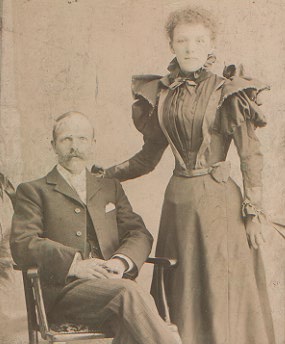 |
A
cheque of the time suggests he was in South Africa in October 1898,
at Gwelo, (now in Zimbabwe). William Appleby, his son, had his birth
(3.12.1898) registered in Barrow on 6.1.1899, so clearly there was some
movement between South Africa and England at this time. |
"The bearer, Mr W C Appleby, has been
employed here as carpenter. I can recommend him as a thoroughly steady
and hard working man who understands his work in all departments" |
A
photograph of c.1898 (see photograph >>) shows him as a prosperous
man and it is said he had expensive tastes in clothes. Another photograph
shows young William by a tricycle outside their home.
The last remaining article in the hands of Duncan Grey is an old rocking
chair, said to have been made by him, presumably for his son and therefore
dated 1900. |
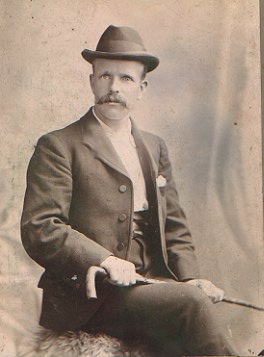 |
| At the
time of his death Martha, William and Irene were in Newcastle,
having returned there on the grounds of Martha's health in 1907 and again
in 1909. William Cunningham was living in the Kimberley Roodepoort
Single Quarters at the Solo Mine, Roodepoort, Krugersdorp. He seems to
have been working for the Roodepoort United Main Reef Gold Mining Co.Ltd. |
His
estate consisted of "Stand 110 Eastleigh Township ... subsequently
found to be unsaleable, a box and tools [which were sold] and £1
in cash." Notice of his death or estate was inserted in each of the
Leader and Gazette 22nd July 1910.
I have an original news clipping, kept by his daughter Irene Appleby, but
I have been unable to trace the newspapers:
the State Library of South Africa cannot trace a newspaper with either
of these titles; the British Newspaper Library claims to have these papers
from Roodepoort, although not for July 1910. |
It was here that he committed
suicide as he was depressed, "going through a bad patch" and
believed himself to be pursued. A newspaper
article in the Rand Daily Mail of December 1909
explains the situation in some detail. Presumably he was not as successful
as he had expected, probably felt isolated from his family and perhaps
found the disgrace of failure too much to bear.
In the previous months he had written back to Martha briefly but on several
occasions, from Roodepoort in July, Brakpan in September, Johannesburg
in late October and November. |
His
death certificate gives the cause of death as "gunshot wound in the
head." The gun used was returned to Martha together with certain
personal effects and is remembered by Irene Grey although she did not
then appreciate its significance. It was said to have been handed to the police
in an amnesty in the late 1960's.
The home address of Martha, William's wife, at his death was given as
53, Richardson Street, Wallsend. She was born in The Close, Newcastle
on January 14th 1875, and may have returned there, to number 84, as young
William lived there for a time, presumably with her. |
A census collector in 1861 adds a personal
note on the Quayside which the Close joins: "This is a portion
of the lowest district in Newcastle, principally inhabited by lodgers,
prostitutes and vendors of fish." |
After her husband's death she was in serious financial trouble, and
in early 1910 was forced to sell her furniture (with the exception of
the rocking chair) and move in with her sister Mary Jane and her husband
Jack (John Ernest Appleby, brother of William.)
A photograph of John Ernest shows him in the uniform of the Tyne River
Police, including two medals. They were then living at 126 Raby Street,
Byker, presumably with their children Joseph and Ivy.
It seems that this arrangement could not last, nor could young William
stay on his own with them, so in April the family moved to Wall in Northumberland,
where Martha had been in service with the Reverend London from the age
of 17 to 22 (when she married.)
|
|
| William
Appleby 1898-1984 |
William was born in Barrow in Furness on 3.12.1898, registered
in Barrow on 6.1.1899,
Young
Irene (known as Rene) was 7 years old at the death of her father. The
vicar could not house both children so on July 18th 1910 young William,
at the age of 10 entered Dame Margaret's Home in Washington County Durham.
On January 12th 1912 he was moved to Leopold House, Stepney, and on
May 17th 1912 to Woodford, a cottage home. Details are available from
Barnados who kept a close record of the boys in their care. There are
photographs of 1912 and 1913. |
The Reverend London thought
highly of Martha.
Dr Barnado's describe her as "in fair
health, and of good character."
William is described as "healthy, intelligent, clean, and
well behaved." He had brown hair, blue eyes, was 4 ft 5inches tall,
weighed 771/2 pounds, had a chest measurement of 24 inches and a freckled
complexion. |
Further
confirmation, if it were needed, that his mother still cared about him,
lies in the fact that she refused to sign the "Canada Clause"
which would have meant that he could have been shipped to Canada to start
a new life.
Finally it is recorded that a letter and a parcel of cake were sent from
Mrs Woods (presumably his grandmother, then 58 years old) who was living
at 5, Trotters Road, The Close, Newcastle, in 1912.
In 1910 Barnados notes that she was at Brokers Yard, The Close, Newcastle,
with Thomas, (1898) and Steven Woods (1894). Another gift to William was
of a purse containing three pennies. |
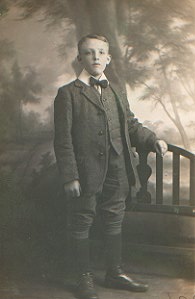 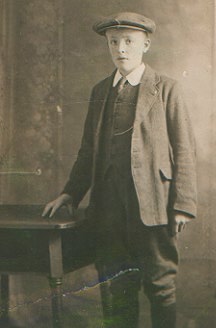 |
On
March 12th 1913 he was "restored to his mother."(see two photographs
from 1912 and 1913 >>)
William recalled
his life in London as an unhappy one. On one occasion, asked to draw an
onion in an art class, he first drew it, then, being hungry, ate it. (sensible
to do so in that order ...)
In 1921 he lived at 84, The Close, Newcastle, whence he corresponded with
the Reverend London concerning matters of his father's will (or lack of
it.)
For many years he lived on St Anthony's Road, Walker, where he lived with
his wife Alice (nee Scott) who he married on 19.4.1924. It is said they
spent their honeymoon (one day only!) at Penshaw Monument. They had two
children, Irene (1926) and Joan (1932). He worked as a scaffolder and
steel erector and was a respected union representative. Later, William
and Alice moved to Hunter House, a high-rise block overlooking the River
Tyne. |
He joined the army for World War I, enlisting
on 2.3.1916 in the Northumberland Fusiliers as Private and serving in
France.
His regimental number was 79514. He was transferred to the Reserve on
29.6.1918 in a Yorkshire Regiment. A Christmas card sent in 1918 adds
"9th (Service) Battn" and the Regimental Symbol plus "XIX". |
Although
Alice died in 1969, William remained active into his 80s. He travelled
widely throughout Europe and also worked at Bainbridge's in Newcastle,
regularly walking several miles to and from work for the sake of keeping
fit, as much as to save money.
The photograph here was taken on the 3rd December 1979, at his 80th birthday.
Soon after the age of 80, however, he declined, and died in St Nicholas'
Hospital on 28.5.1984.
A quiet man and a good one. |
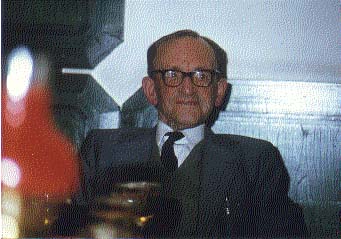 |
His sister Rene died in August 1992, having maintained her independence
fiercely to the last.
The relics which she kept, in the form of photographs and memorabilia
brought back from travels by her father were shared between Irene and
Joan, her nieces, and Duncan and Robin, her great nephews. |
After his death a friend of his,
George Blaylock, wrote to Irene:
"Your father and I were at Grasmere for
a week; and didn't we talk! What an experience it was to me! His quiet
calm way possessed a deep experienced mind which one had to watch for,
and I'm sure some would miss. .. How could one forget a humble Natural
Gentleman?" |




